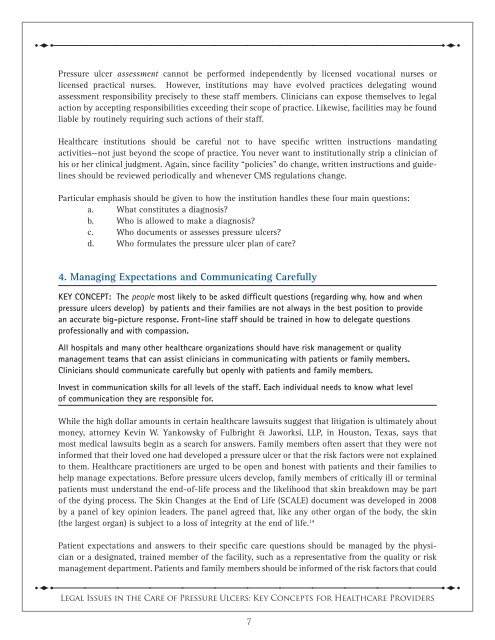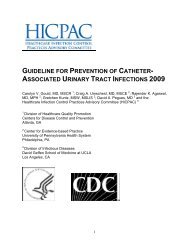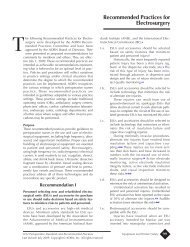Legal Issues in the Care of Pressure Ulcer Patients - Medline
Legal Issues in the Care of Pressure Ulcer Patients - Medline
Legal Issues in the Care of Pressure Ulcer Patients - Medline
You also want an ePaper? Increase the reach of your titles
YUMPU automatically turns print PDFs into web optimized ePapers that Google loves.
stttttttttttts<strong>Pressure</strong> ulcer assessment cannot be performed <strong>in</strong>dependently by licensed vocational nurses orlicensed practical nurses. However, <strong>in</strong>stitutions may have evolved practices delegat<strong>in</strong>g woundassessment responsibility precisely to <strong>the</strong>se staff members. Cl<strong>in</strong>icians can expose <strong>the</strong>mselves to legalaction by accept<strong>in</strong>g responsibilities exceed<strong>in</strong>g <strong>the</strong>ir scope <strong>of</strong> practice. Likewise, facilities may be foundliable by rout<strong>in</strong>ely requir<strong>in</strong>g such actions <strong>of</strong> <strong>the</strong>ir staff.Healthcare <strong>in</strong>stitutions should be careful not to have specific written <strong>in</strong>structions mandat<strong>in</strong>gactivities—not just beyond <strong>the</strong> scope <strong>of</strong> practice. You never want to <strong>in</strong>stitutionally strip a cl<strong>in</strong>ician <strong>of</strong>his or her cl<strong>in</strong>ical judgment. Aga<strong>in</strong>, s<strong>in</strong>ce facility “policies” do change, written <strong>in</strong>structions and guidel<strong>in</strong>esshould be reviewed periodically and whenever CMS regulations change.Particular emphasis should be given to how <strong>the</strong> <strong>in</strong>stitution handles <strong>the</strong>se four ma<strong>in</strong> questions:a. What constitutes a diagnosis?b. Who is allowed to make a diagnosis?c. Who documents or assesses pressure ulcers?d. Who formulates <strong>the</strong> pressure ulcer plan <strong>of</strong> care?4. Manag<strong>in</strong>g Expectations and Communicat<strong>in</strong>g <strong>Care</strong>fullyKey Concept: The people most likely to be asked difficult questions (regard<strong>in</strong>g why, how and whenpressure ulcers develop) by patients and <strong>the</strong>ir families are not always <strong>in</strong> <strong>the</strong> best position to providean accurate big-picture response. Front-l<strong>in</strong>e staff should be tra<strong>in</strong>ed <strong>in</strong> how to delegate questionspr<strong>of</strong>essionally and with compassion.All hospitals and many o<strong>the</strong>r healthcare organizations should have risk management or qualitymanagement teams that can assist cl<strong>in</strong>icians <strong>in</strong> communicat<strong>in</strong>g with patients or family members.Cl<strong>in</strong>icians should communicate carefully but openly with patients and family members.Invest <strong>in</strong> communication skills for all levels <strong>of</strong> <strong>the</strong> staff. Each <strong>in</strong>dividual needs to know what level<strong>of</strong> communication <strong>the</strong>y are responsible for.While <strong>the</strong> high dollar amounts <strong>in</strong> certa<strong>in</strong> healthcare lawsuits suggest that litigation is ultimately aboutmoney, attorney Kev<strong>in</strong> W. Yankowsky <strong>of</strong> Fulbright & Jaworksi, LLP, <strong>in</strong> Houston, Texas, says thatmost medical lawsuits beg<strong>in</strong> as a search for answers. Family members <strong>of</strong>ten assert that <strong>the</strong>y were not<strong>in</strong>formed that <strong>the</strong>ir loved one had developed a pressure ulcer or that <strong>the</strong> risk factors were not expla<strong>in</strong>edto <strong>the</strong>m. Healthcare practitioners are urged to be open and honest with patients and <strong>the</strong>ir families tohelp manage expectations. Before pressure ulcers develop, family members <strong>of</strong> critically ill or term<strong>in</strong>alpatients must understand <strong>the</strong> end-<strong>of</strong>-life process and <strong>the</strong> likelihood that sk<strong>in</strong> breakdown may be part<strong>of</strong> <strong>the</strong> dy<strong>in</strong>g process. The Sk<strong>in</strong> Changes at <strong>the</strong> End <strong>of</strong> Life (SCALE) document was developed <strong>in</strong> 2008by a panel <strong>of</strong> key op<strong>in</strong>ion leaders. The panel agreed that, like any o<strong>the</strong>r organ <strong>of</strong> <strong>the</strong> body, <strong>the</strong> sk<strong>in</strong>(<strong>the</strong> largest organ) is subject to a loss <strong>of</strong> <strong>in</strong>tegrity at <strong>the</strong> end <strong>of</strong> life. 14Patient expectations and answers to <strong>the</strong>ir specific care questions should be managed by <strong>the</strong> physicianor a designated, tra<strong>in</strong>ed member <strong>of</strong> <strong>the</strong> facility, such as a representative from <strong>the</strong> quality or riskmanagement department. <strong>Patients</strong> and family members should be <strong>in</strong>formed <strong>of</strong> <strong>the</strong> risk factors that couldstttttttttttts<strong>Legal</strong> <strong>Issues</strong> <strong>in</strong> <strong>the</strong> <strong>Care</strong> <strong>of</strong> <strong>Pressure</strong> <strong>Ulcer</strong>s: Key Concepts for Healthcare Providers7
















